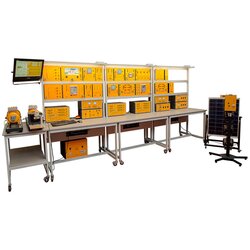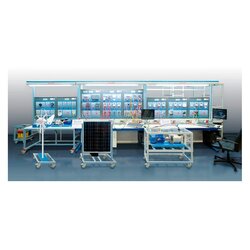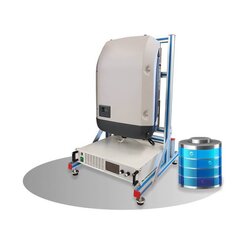Smart Grid 2.0 (DL SGWD2.0)
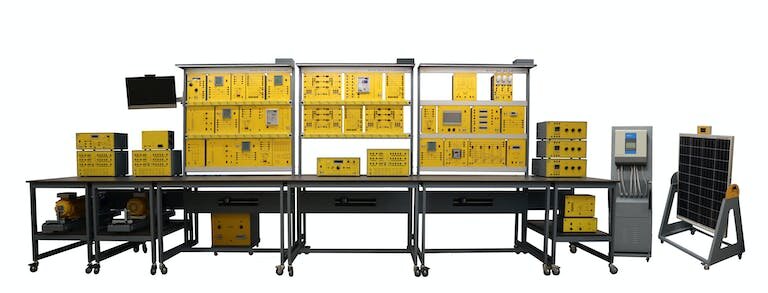

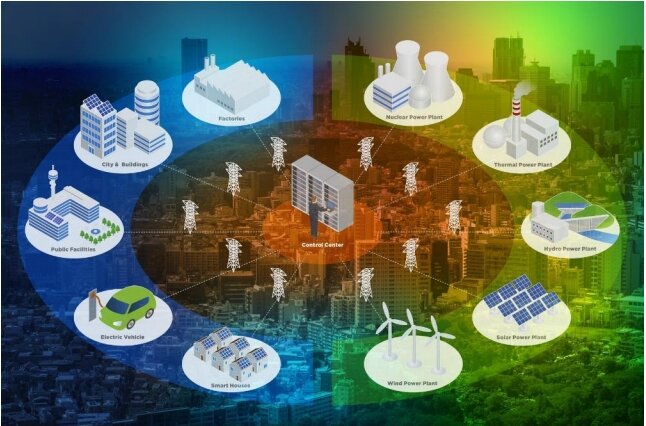
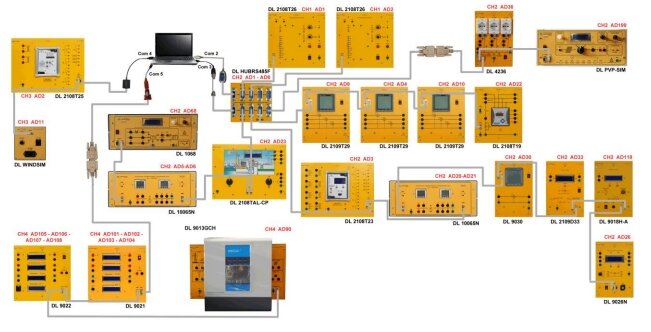
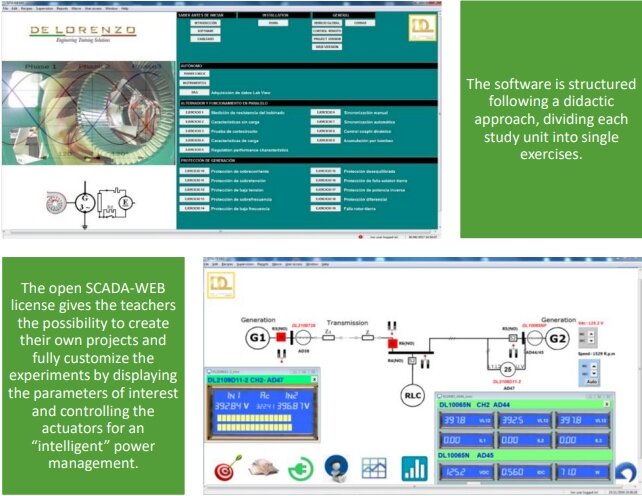
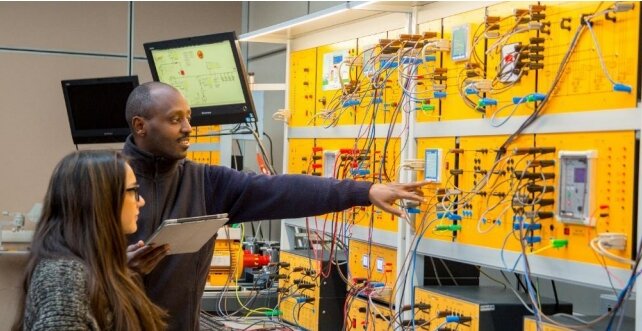
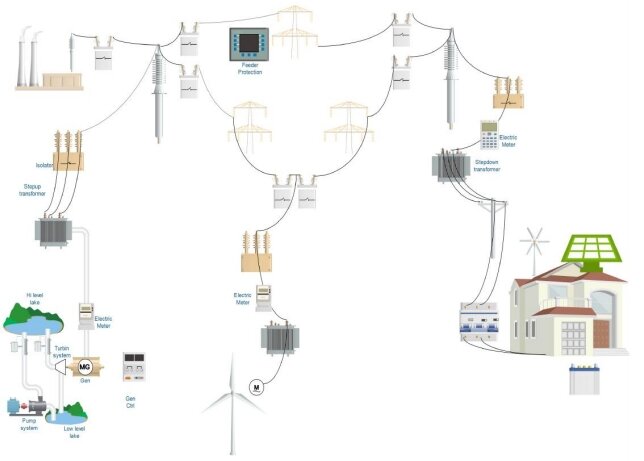
PL-450166
De Lorenzo has designed a modular trainer that studies the power flow and interaction between the electricity supplier’s networks (generation, transmission, and distribution systems) and the consumers (residential and/or commercial customers).
Industrial grade equipment has been integrated into a controlled environment, providing a flexible and reconfigurable learning platform to study electrical power engineering applications. The core of the laboratory is a simplified scaled-down model of a power distribution system. Several power sources from different renewable energies are connected to the system on different points simulating a distributed power generation system. The energy can be added from the production side (high and mid voltage) or from the end-user side (microgrid).
The system includes 3 different energy generation subsystems:
- A variable pitch wind plant.
- A hydroelectric plant with pumped storage.
- Micro-grid energy sources using a solar photovoltaic system with battery storage and an optional micro-wind system generating energy from the low voltage side of the grid.
A double busbar system and circuit breakers allow the isolation of sections of the system or the insertion of the available renewable energy sources to create a bidirectional power flow in the distribution network.
A set of active measurement devices are strategically placed to monitor the power flow in the system in real time and provide protection. The operation of the laboratory is done through the SCADA software.
An industrial feeder manager relay can be configured to study the protection techniques at different points of the system.
Transmission and distribution system:
At the core of the system, the Smart Grid laboratory includes all the modules to simulate a simplified distribution system with unidirectional power flow, transmitting energy from a conventional thermal plant to an end user.
- A power supply connected to the mains represents a coal plant connected to the infinite bus.
- HV transmission lines of several lengths, busbar, and power switches simulate the power distribution and transmission system.
- Dedicated measurement devices are distributed in key points of the system to monitor the power flow.
- Industrial feeder manager relay provides protection to specific sections of the system.
Energy use and consumption:
The end user represented by an RLC load and a load management system to simulate different consumption profiles.
- An isolation transformer acts as a step down transformer.
- Automatic power factor compensator with capacitor banks.
- Variable resistive, inductive and capacitive loads simulate the end-users consumption.
- Energy meter, load manager and HMI simulate different consumption profiles acting as a smart user that can regulate his consumption based on his requirements and the cost of energy.
Hydro-electric system:
The hydroelectric plant is simulated by a three-phase synchronous machine that can be used to generate power or to simulate a pumped storage system to handle the excess of energy in the grid.
- Brushless servo-motor that represents the pelton turbine of a hydro power plant.
- Synchronous generator that transforms the mechanical power into electricity.
- Excitation controller with droop V/Q function for closed loop regulation of the reactive power when connected to the grid.
- Isolation transformer that acts as a step-up transformer.
- Synchronization relay to connect the generator to the grid.
Wind power system:
A variable pitch wind plant is simulated with a three-phase asynchronous induction machine.
- Brushless servo-motor that represents a wind turbine.
- Asynchronous machine transforms the mechanical power into electricity.
- Isolation transformer that acts as a step-up transformer.
- Network power analyzer.
Microgrid solar:
From the end user side, different power sources provide energy to the system.
- Real solar photovoltaic panel illuminated with a halogen light source that simulates the sun.
- Photovoltaic panel simulator: programmable DC power supply that behaves as a solar panel providing power to the single-phase grid tie inverter.
- An inverter charger-module further expands the features of the solar system providing storage capabilities.
- Dedicated instruments and load provide the information needed for the characterization of the solar panel and measure the flow of power to the system.
- A programmable active DC load is used to characterize the solar panel.
OPEN SCADA-WEB
The full system is integrated by an industrial Supervision and Control Data Acquisition (SCADA) software that communicates with all the active devices in the trainer and performs the following actions:
- acquisition and measurements of the physical quantities of the system;
- control of the system’s operation;
- visual supervision of the system (also in remote mode), through the use of synoptic diagrams: operational status, alarms, etc.
Through the SCADA software, the operator can monitor the electric flow in the system to manage and optimize the power requirements based on the consumption, through the acquisition of real-time data from the measuring devices and protection relays and the control of actuators for an “intelligent” management of the whole electrical system.
The different sections of the trainer communicate through ethernet and dedicated serial RS485 buses using standard insutrial communication protocols such as MODBUS RTU.
The SCADA project is divided in templates each one corresponding to a particular exercise. The open SCADA- WEB developers license provided with the trainer allows the teachers to fully customize the existing templates or create new ones that can be used to monitor the system from a local workstation.
SCADA main features
The software is structured following a didactic approach, dividing each study unit into single exercises.
The open SCADA-WEB license gives the teachers the possibility to create their own projects and fully customize the experiments by displaying the parameters of interest and controlling the actuators for an “intelligent” power management.
TRAINING OBJECTIVES
The Smart Grid trainer is a multidisciplinary laboratory, aimed at undergraduate and graduate courses in the engineering schools for the study of energy management in a modern power grid. The laboratory equipment can be configured to create different exercises, which reinforce basic and advanced concepts in electric energy.
The smart grid system is an integrated laboratory that can be used by mechanical and electrical engineering students as a longtime project as it comprises enough elements to cover most of the topics such as electric circuits, electric machinery, hydroelectricity, renewable energies, power transmission, and power distribution. The main purpose is to study the principles of power engineering and study the power flow to develop advanced energy management strategies.
The entire system is fully configurable and can be tested under many conditions. Different experiments can be performed by rearranging the wiring and placement of the modules giving a lot of flexibility to simulate a full smart grid system with various network topologies. The proposed exercises in different topics connect theoretical and practical concepts through hands-on experience.
This innovative laboratory can include class demonstrations and laboratory experiments under regular laboratory classes. It provides a controlled and safe platform for further experimentation to simulate different network conditions and faults to study network efficiency, stability, and protection. The system architecture which uses standard industrial communication protocols and a fully customizable open SCADA software, makes it a complementary tool for research and development, further expanding its capabilities.
Skills development:
- Basic:
- Circuits theory: validate the basic electric laws and circuit theory using three-phase power.
- Electrical measurements: Use of industrial measurement devices and protection relays.
- Renewable energies: photovoltaic energy, Wind energy.
- Intermediate:
- Electric machines: study of a three-phase transformer and alternator or a motor acting as load.
- Power electrical engineering: generation, transmission, distribution and use of electrical power.
- Power electronics, control systems, digital control, embedded systems.
- Energy Storage
- Advanced:
- Grid: Study of different network topologies.
- Energy management: Power flow control, fault simulation and troubleshooting.
- Power system stability, droop control.
- Intelligent power systems "Smart Grid".
- Energy cost and optimization methods.
- Stochastic processes, prediction, and data analytics.
LIST OF EXPERIMENTS
LOAD ANALYSIS
- R, L, C load characteristics
- Active energy measurement
- Reactive energy measurement
- Manual power factor compensation
- Automatic power factor compensation
HYDROELECTRICAL SYSTEM
- Generator no-load characteristic
- Generator load characteristic
- Regulation performances characteristics
- Automatic synchronization
- Reactive power regulation (Droop V/Q)
- Pumped storage
- Overcurrent protection
- Over-voltage and under-voltage protection
- Over-frequency or under-frequency protection
WIND SYSTEM
- The relation between a pitch control system and wind
- Analysis of the mechanical parameters within an induction generator
- Analysis of electrical parameters within an induction generator
MICROGRID SYSTEM
- Characterization of a photovoltaic panel without a load
- Characterization of a photovoltaic panel with a load
- Connecting a photovoltaic system to the real network by using an inverter grid system single-phase.
- Solar power battery storage
TRANSFORMER
- Vector group
- No-load performance
- Load performance
- Asymmetrical performance
- Regulation performance
TRANSMISSION
- No-load performances
- Matched-load performances
- Ohmic-inductive load
- Ohmic-capacitive load
- Radial network
- Meshed network
- Transmission line earth-fault
- Transmission line symmetrical short circuit
- Transmission line asymmetrical short circuit
- Transmission line earth-fault protection
- Transmission line instant and definite time overcurrent protection
- Transmission line under-voltage protection
DISTRIBUTION:
- Basic double busbar system
- Double busbar system with load
- Busbar coupling
SMART GRID
- Contribution of microgrid energy
- Contribution of hydropower
- Contribution of wind plant
LIST OF MODULES
DL 2108T26: Brushless Controller With Motor:
DL 2108T26BR: Braking resistance:
DL 1021/4: Three-Phase Asynchronous Motor:
DL 1013A: Base:
DL 1026P4: Three-Phase Synchronous Machine:
DL 1017R: Resistive Load:
DL 1017L: Inductive Load:
DL 1017C: Capacitive Load:
DL 2108TAL‐CP: Three Phase Supply Unit:
DL 1068: AC Machine excitation and droop V-Q controller:
DL 7901TT: Overhead Line Model – 360 Km:
DL 7901TTS: Overhead Line Model – 110 Km:
DL 2109T29: Three‐Phase Power Meter:
DL 2108T25: Generator Synchronizing Relay:
DL 2108T23: Feeder Manager Relay:
DL 2108T02: Power Circuit Breaker:
DL 2108T02A: Power Circuit Breaker:
DL 2108T02/2: Double busbar:
DL 2108T19: Reactive Power Controller:
DL 2108T20: Switchable Capacitor Battery:
DL 2108T20C: Rephasing capacitor module for induction machine:
DL 4236: Load manager:
DL HMI: Human machine interface:
DL 2109T34: Three-phase active and reactive energy meter:
DL 9013G: Inverter Grid:
DL 9013G1C: Sigle phase inverter charger:
BAT100AGM: 12V - 100Ah Battery:
PFS-85: Photovoltaic Solar Panel:
DL SIMSUN: Lamps For The Photovoltaic Solar Panel:
DL 9021: Measurement module for photovoltaic panels:
DL 9018H-A: DC Active load:
DL 2101T13-DC: Transformer with rectifier:
DL PVP-SIM: Photovoltaic panel simulator:
DL HUBRS485F: Modbus Communication Hub:
DL SCADA3+: Software Scada:
DL 1080TT: Three‐Phase Transformer:
DL 1155SGWD: Kit Of Connecting Leads:
DL T12090: 120x90 Working Bench:
DL T06090: 60x90 Working Bench:
DL A120-3M-LED: Frame:
DL PCGRID: All-In-One Personal Computer:
DL 2100TTI: Three-Phase Transformer:
DL 1196: Holder For Leads:
Options:
- Microgrid wind energy: It allows adding a microgrid wind energy system in parallel to the photovoltaic solar system at the user end of the system – ordering code: DL SGWD2.0-W.
- A micro-grid wind turbine powered by a servo-motor simulating the action of the wind.
- A single phase grid-tie inverter that feeds power from the turbine into the mains
- Dedicated instrument provide the information needed for the characterization of the wind system.
What is this?
These percentage scores are an average of 0 user reviews. To get more into detail, see each review and comments as per below
If you have used this product, support the community by submitting your review
